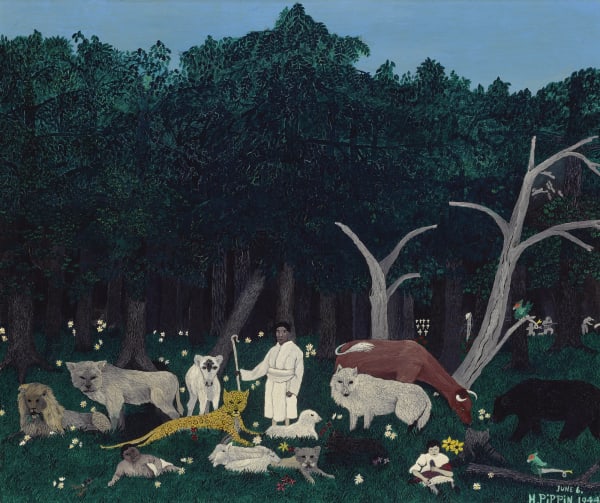Horace Pippin American, 1888-1946
Self-taught painter Horace Pippin became one of the foremost African American artists of the 20th century with his singular, color-driven aesthetic and distinctive vision of American life.
—Colton Klein
In 1917 at the age of 29, Horace Pippin enlisted in the National Guard. After sustaining a crippling wound to his right shoulder, Pippin was honorably discharged and returned to his hometown of West Chester, Pennsylvania, and he began decorating cigar boxes with charcoal as therapy for his injured arm.
Enthused by his newfound sense of purpose, Pippin soon expanded his creative production and began working in other mediums, completing his first painting, The End of the War: Starting Home, in 1930, now in the collection of the Philadelphia Museum of Art. Though his works from this period were unknown beyond his immediate circle, by the end of the decade he had gained national recognition for his paintings.
Throughout his career Pippin was less concerned with faithfully portraying his subjects and more focused on capturing a specific vision. He utilized the dynamic power and structural function of color to convey emotion, relying on subjects both conjured from memory and drawn from the world around him
“My opinion of art is that a man should have love for it, because my idea is that he paints from his heart and mind”
Horace Pippin was a self-taught African-American artist known for his poetic paintings of flowers, genre scenes, and historical events such as the hanging of the abolitionist John Brown. With their rich colors and idiosyncratic approach to organizing space, paintings such as Domino Players (1943), are both timeless and charged with life.
“My opinion of art is that a man should have love for it, because my idea is that he paints from his heart and mind,” he once reflected. Born on February 22, 1888 in West Chester, PA, he grew up in Middletown, NY, beginning to draw at an early age. Moving to New Jersey in 1902, Pippin worked as a mover and iron molder prior to enlisting in the United States Army in 1917. Shot by a sniper while serving in World War I, the artist’s right arm was permanently disabled before he returned to the United States in 1919.
Upon his return, he moved to West Chester with his new wife and worked odd jobs that didn’t require manual labor, mainly living of his military pension. In 1928, Pippin began producing paintings on cigar boxes, and over the following decades, he gained the attention of artists such as N.C. Wyeth and collectors like Albert C. Barnes. As he painted more, the artist began incorporating imagery from early American artists, such as Edward Hicks and Winslow Homer. Before he died on July 6, 1946 in West Chester, PA, Pippin had been widely exhibited at institutions throughout the country. Today, his works are held in the collections of the National Gallery of Art in Washington, D.C., the Art Institute of Chicago, and The Museum of Modern Art in New York, among others.




